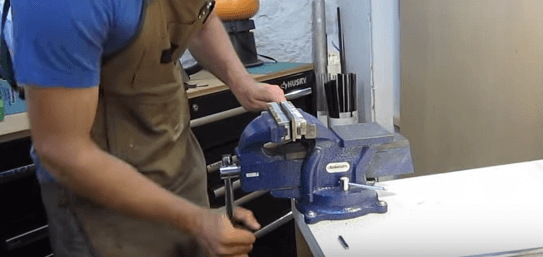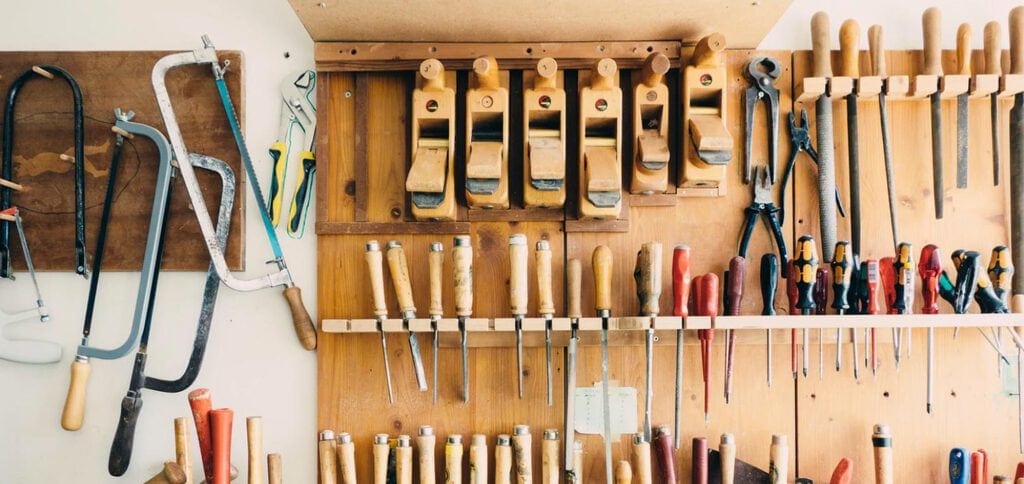What is a Hacksaw?
Hacksaws were originally designed to cut metal, but are just as widely used for cutting plastic pipes and conduit for your DIY electrical and plumbing jobs. A hacksaw is something that every man should have handy in his tool box, as these make great additions to your repertoire as a DIY-er.
Hacksaws can be used to cut wood, although it would be better to use a handsaw for this. The cool thing about a hacksaw, is that you can hold it perpendicular or parallel to the frame you are using and cut the metal, plastic or wood you are working with. Don't forget to checkout our review on All Hand Saw Types
Best Hacksaw - Intro
The most commonly used hacksaws come with standard 10" or 12" blades. Junior hacksaws also come with a standard 6" blade, and this allows for much more precise cutting than a standard-sized hacksaw. Powered hacksaws come in a variety of sizes and all hacksaw blades typically come either in carbon steel or high speed steel. Let's learn a little about a few specific hacksaws, so that you can see which is the best hacksaw for your specific needs.
Hacksaws come in a variety of sizes as far as blades are concerned, and some are adjustable so that they fit multiple-sized blades. Depending on what kind of cut you're looking for, hacksaws come in 14, 18, 24, or 32 teeth per inch (tpi). The fewer tpi, the bigger the object you should be cutting.
What to Consider:
Frame:
- Material: the best type of hacksaw, the one that will last you a lifetime, is made of steel. Frames do come in aluminum, but finding a lightweight steel frame is better for the money and for quality.
- Weight: You want to pick a hacksaw that is light weight so that you don't get pooped out just working that hacksaw back and forth. You're sure to get tired just by sawing the metal or pvc pipe, but having a heavy hacksaw tires you out much more quickly.
- Length: The frame length varies, but the most common lightweight yet sturdy frame is a 10-inch frame. It wouldn't hurt to have multiple hacksaws in your tool box, but if you have to choose just one, a 10-inch is best.
- Mounting Pins: Having two rows of mounting pins allows you to tilt the hacksaw and get a much better, bigger cut. Although the hacksaw is at an angle, the cut is still straight and goes much further than one with only one set of two mounting pins.
Blade:
- Type of metal:
- High-carbon steel -These are commonly used and work well when sharp. However, because these blades aren't heat resistant, the teeth dull more quickly.
- Bi-metal- The teeth of these are made of high-speed steel and bonded to a back of spring steel, which helps keep cost down, but these blades last a long time.
- Length: Whatever length the frame is, that's the length of blade you need to purchase for it. A 10-inch frame should have a 10-inch blade.
- TPI (# of teeth-per-inch): The more teeth per inch, the thinner the material you can cut. (i.e. if you have to cut a thick, 1-inch piece of steel, you want the lowest number of tpi possible.
- 18 tpi: minimum thickness of material to cut is 5/32 in. or 4 mm
- 24 tpi: minimum thickness of material to cut is 1/8 in. or 3 mm
- 32 tpi: minimum thickness of material to cut is 3/32 in. or 2.5 mm
How to Use a Hacksaw
Before you use the hacksaw for the first time, you must be sure that the blade is well-tensioned. You don't want to break the blade right out of the gate.
When you purchase a hacksaw, the standard blade may come already set in the saw. However, you'll need to learn very quickly how to change out the blade or how to install different blades into the saw yourself. You'll need to first turn the adjustor on the saw handle or frame. Every hacksaw is different when it comes to replacing the blade.
The teeth on a hacksaw are meant to cut only on the forward stroke, the push stroke. This means that when you are pushing, you need to add pressure so you'll cut the material. However, when drawing the hacksaw back, you will want to let up on the pressure. If you don't let up on the pressure when drawing back, you're not cutting anything, but you are definitely dulling the teeth more quickly. You want your blades to last as long as possible.
How you hold a hacksaw is very important to your success in cutting whatever material you're working with. When getting ready to cut, the hand in the rear should be in a pistol-grip with your pointer finger pointing along the blade. Your front hand should be on the front of the frame. This allows you initially to put more pressure down to cut.Once you have established the cut, both hands can be moved to the back of the frame, which allows the most pressure and direction.

The final thing that you should care about is how you are going to hold the material you plan to cut. You have to be sure that you don't waste any energy by allowing your material or your work bench to move one iota. How will you be sure it's all 100% secure? The most successful way to do this is by having a vice that is mounted securely to your work bench. If you can't afford a vice, you have to at least get some sturdy clamps to make sure your material is securely placed on the work bench before you begin cutting.

What happens if your cut begins to move away from where you want it to be? The hacksaw allows you to correct your cut simply by turning the frame slightly in one direction or another. It's actually pretty simple. This twists the flexible blade, which causes the blade to cut more on one side than on the other.
Last update on 2024-07-27 / Affiliate links / Images from Amazon Product Advertising API
Best Hacksaw- Budget
The Tekton 6823 2-in-1 High Tension Hacksaw rates best on a budget for your needs. The lightweight hacksaw has everything you need, including storage for up to 6 extra blades. It's inexpensive, but you're not going to pay a whole lot for any hacksaw, so let's focus on something that means more to you: quality and what others are saying about this hacksaw.

hacksaw best overall
This is the best working hacksaw I've ever owned. The blade doesn't wobble side to side. It stays perfectly straight and makes cutting to a line quite easy. The handle is comfortable and the front of the saw is easy to grasp with your other hand for even more control. A well made well thought out tool at a great low price.
 David Anderson - Amazon Reviewer
David Anderson - Amazon ReviewerMJR -from Ohio says that this hacksaw is "Solidly made. Two positions for straight or flush cutting. Very pleased with the product."
In addition to this hacksaw being cost-effective, it really does get the job done. Listen to what Jo-Jo says about a job well done:
"I had a pretty thick pipe sticking out of my ground in the backyard where a previous owner had cemented it in to use as a post. I know that hacksaws cut through metal and I also know that some are better at it than others. Given that this saw was much less than many others on Amazon, I was surprised at how quickly and easily I was able to saw through the pipe. Worked for me; would recommend for smaller jobs at least." - Jo-Jo '77 - Amazon Review
Best Hacksaw- Versatility

This versatile hacksaw is 5-in-1. It's a little on the heavy side, but it's manufactured in the United States and can handle both standard and flush cuts because you can put the blade at a 45 or 90- degree angle. It's known for being able to cut in tight spaces and one of its coolest features is that the front of it becomes a jab saw. If you're only permitted one hacksaw in your toolbox, this is the one you have to purchase.
"High tension securely holds the blade up to 330 lbs."
Excited about a hacksaw?- Theo is!
"This 5 in 1 multi-purpose tool Excels at its primary job with Superior control, comfort and speed in cutting metal(all I every really wanted). The quick release and fine blade adjustment is a snap to set and allows for precise tensioning, giving me smoother, more accurate cuts. The smooth ergonomic grip of the main assembly is solid and very comfortable...No more hand cramping! Keeping with the 12" blade set, securing the blade to the "45 Degree Pins" assist in creating smooth flush cuts. Then, sliding the head off allows attachment of the 12" blade to the tip of main assembly, creating a "Low Profile Saw" for precise tight control. Also in this main profile configuration, the 12" blade can be secured into the main body head, creating a -short to long straight reach- "Tight Access" saw to meet minimal clearances. Finally, the removed head ergonomic grip will accept a short to long blade for "Jab Saw" rough cutout activity. On top of all this, the main assembly head can hold an extra 12" blade and 4 other shorter blades for all kinds of projects. With all of these high performing feature sets in one lightweight tool, a reasonable asking price and a DeWalt Lifetime Warranty, guess I have another 35+ years of trouble free projects to tackle!!!" - Theo (Amazon Review)
Best Hacksaw- Lightweight

This hacksaw weighs only 1.2 pounds, so using it won't tucker you out immediately. Its sturdy construction makes this a contender for best hacksaw for mid-level DIY projects you may be doing around the house. This hacksaw is perfect for cutting pvc pipe!
"Well Built"
"Great hacksaw, blades are held very well and it seems well built. I have no issues with this saw and expect it to last a long time" - Todd (Amazon Review)
"I've used several times on PVC pipes and it cuts so quickly. Awesome purchase." - Amazon Reviewer
With a hacksaw, most of the time you get what you pay for. Be sure that you do the legwork by reading and researching, and then based on what you're going to be doing as far as DIY projects, pick the best hacksaw for you. You won't regret buying something you find that you love to use and something that will last you.




